





When I first glimpsed one of these spectacular trees for sale at my local nursery I was sure it was some sort of gimmick and too good to be true. Usually when something that different and attractive is offered, it means I will quickly be adding it to my long list of dead plants. It turned out to be a good buy after all, and I have yet to regret my purchase. The following is a brief discussion of this amazing relatively new tree available for landscaping all over the southern U.S.
The Mimosa Tree, Albizia jilibrissin, is a very common and well-known landscape tree throughout the southern U.S., and there are obviously some mixed feelings about this species. Just visit the Dave's Garden Plantfiles entry for Albizia julibrissin to discover the full gamut of opinions about this tree, ranging from glorification to near-loathing. It is one of the most commented-upon species in the entire Plantfiles. Personally, I find this tree an attractive one, and since I live in the desert of southern California, the problems of its invasiveness are not a concern for me. It is, however, an incredibly messy, dirty tree and I prefer to enjoy it in other people's yards, not my own.
So I was a little nervous when I got this 'Summer Chocolate' version of Mimosa, and I wondered if I would regret it someday. It was relatively costly for a 5-gallon plant, but it grew great and is now in its third year in my yard. My wife thinks it's our best-looking tree in the yard (she does not like palm trees much). The price has since come down and these trees seem to be coming more widely available. Still, I have yet to glimpse another in any yards here in Los Angeles.
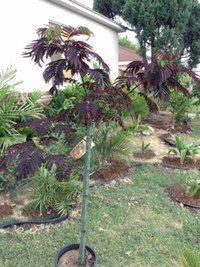
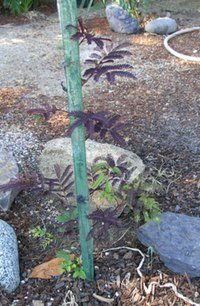
plant in pot as I bought it showing new growth near ground (since removed)
It turns out this is a relatively new cultivar of Mimosa, discovered in 1990 by Masato Yokoi in Japan as a brown version of one of his normally green seedlings. Hines Horticultural in Irvine, California obtained a patent and called it ‘Summer Chocolate', which I personally think is a great name. The recent arrival on the horticultural scene may be why I have not seen the cultivar growing in everyone's yard, yet. Some online sources of this tree say it grows to 20 feet tall, about half the potential height of the normal green form. I don't know if this is a ‘fact' yet, or if it just hasn't been around long enough to get that large. I have to say it does seem to grow much slower than green ones I have had in the past, so perhaps it will be a more manageable size and I may still not regret planting it.
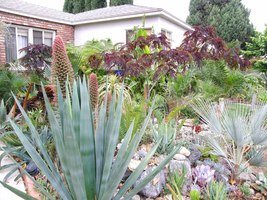
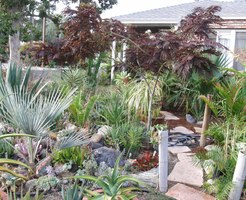
look in spring look in summer
This plant is one of the few that really looks as good as it sounds. Many weird-colored plants seem to get bleached by our blistering hot summer sun, but it has little effect on the deep maroon to brown coloration of the leaves of this tree (though some brown-tipping occurs on the upper-most leaves if it gets over 110 F). The tree leafs out in early spring and the new leaves are green. However, they quickly turn brown as they mature, and by early summer the tree is a maroon-brown anomaly in my sea of green foliage. It really stands out and is a striking specimen. My tree has already flowered for 2 years, though not profusely. The flowers are a very pale pink and not very ornamental. This is definitely a foliage tree! Sadly, when winter comes, leaves fall off (the tree is bare from about mid November to March here in Southern California.)
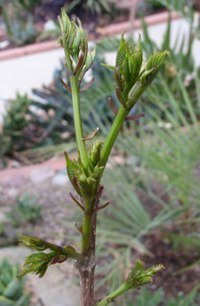
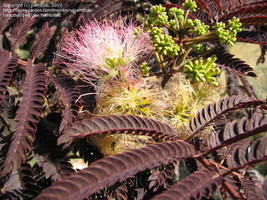
New growth in spring (green) Flower in mid summer
From what I understand propagation is primarily from cuttings taken in late winter, or from trying to root the offsets. I suspect seed will produce green, normal seedlings. Someone at Hines has figured it out though as they never seem to run out of this tree at the local nursery here (though they cleverly only have 2 or 3 out at a time--they probably don't want to give the impression these are common!)
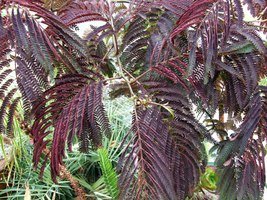
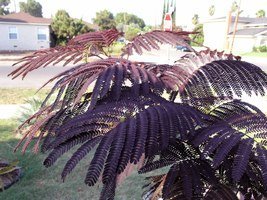
looks in different lighting
If your climate can support it and you have a little extra room for an unusual tree, you might look around for one. They are almost good enough to eat!
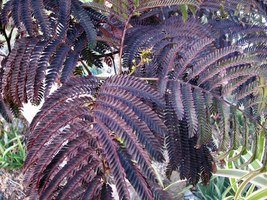
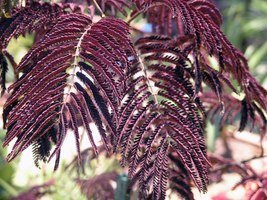
(Editor's Note: This article was originally published on February 15, 2009. Your comments are welcome, but please be aware that authors of previously published articles may not be able to promptly respond to new questions or comments.)
Copyright © www.100flowers.win Botanic Garden All Rights Reserved